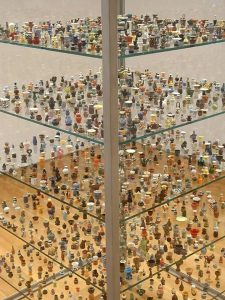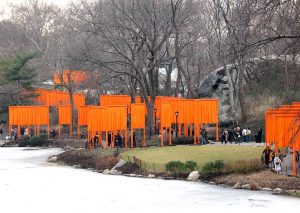First Impressions of the South Dakota Symphony
 Editor's Abstract
Editor's Abstract
Michael Manley, who formerly worked at the national office of the AFM, is one of this year’s American Symphony Orchestra League’s Management Fellows. Each fellow works with four orchestras for a few months each during the course of the fellowship year. Michael is spending the winter months in Sioux Falls, South Dakota, after a time in Aspen and the Los Angeles area with the Pacific Symphony. He heads to Cleveland in the spring.
I asked Michael to write about his year as a League Management Fellow — in particular what motivated him to leave his union work to pursue a career in orchestra management. He’s still working on that article, but sent his impressions of working with the South Dakota Symphony, a piece he prepared for their Annual Meeting. Michael is a very artistic kind of guy (he’s a playwright as well as a hornist); I hope you enjoy his art comparisons and contrasts as much as I do!
Ann Drinan
I’ve been asked, as an American Symphony Orchestra League Management Fellow newly-arrived to South Dakota, to share a few of my initial impressions about the South Dakota Symphony. In pondering this, my thoughts keep coming back to scale. I don’t mean a musical scale, but scale as a measure of size, or maybe more crucially, scale as a measure of impact.
Before I started this program, I worked in New York City, right in Times Square. Walking down the street to get a sandwich for lunch, I might pass 2000 people in 5 blocks. In New York you appreciate scale, at least as a measure of size. When I told my New York friends and colleagues I was heading to South Dakota for one of my Fellowship assignments, their first response was “Why?” I explained that there was a professional orchestra in Sioux Falls, the South Dakota Symphony. To which they would reply, “Why?” This response betrayed a certain New York attitude, which assumes that New York is the center of the known universe. It’s so big, after all, and so much happens there. But what if New York isn’t the center of the cultural universe? Or here’s a radical idea: what if the cultural universe has no center at all?
As I said, I’ve been thinking about scale, and another radical idea that occurs to me is that size has little to do with impact.
Two winters ago in New York City, I remember anxiously awaiting my first look at something called The Gates. The Gates was the multi-million dollar, decades-in-the-making dream project of the artist Christo and his wife Jeanne-Claude, and it consisted of more than seven thousand huge traffic cone-colored fabric panels hung from these big free-standing frames throughout Central Park. Millions of dollars, years of construction and preparation, hundreds of volunteers, and months of set up time…it was a Very Big Deal. I was excited to see The Gates—the absurdity of its scale was overwhelming on its own; I was sure seeing it in person would have a huge impact. But The Gates left me cold; it seemed oddly mundane, reducing Central Park to a crime scene, or construction site. I tried to keep an open mind—maybe I needed to see it in sunlight, or after a snowfall. I waited for The Gates to reveal its wonders to me, but I never ‘got’ it. People came from all over the world to see the Gates.
If any of the international Gates tourists had made it to the Museum of Modern Art, a few blocks south of Central Park, they might’ve stepped off the third floor escalator to find themselves staring at a tall glass case containing six glass shelves about 3 feet square.

Charles LeDray's Oasis 2002. Collection of the Museum of Modern Art, New York; Courtesy Sperone Westwater, New York
On each shelf they would see several hand-thrown ceramic pottery vessels; each painted and glazed in different colors and patterns. They would be struck by the fact that no single vessel was taller than an inch, and that each shelf contained not just several, but several hundred of these small pots. Over 2000 in all, each hand-made, each unique, each expertly crafted. It did not take millions of dollars or an army of construction workers, or exceptions to the building code for artist Charles LeDray to create his untitled constellation of hand-crafted pots, which taken together suggest the infinite. It did not take essays, interviews, models, sketches, or blueprints to convey its power or explain its intention. What did it take Mr. LeDray, who worked entirely alone, to make this piece? Endless amounts of time, skill, focus and patience—and an innate understanding that scale is relative; that size is not impact. Of course, Christo is more famous than Charles LeDray—if your name is one word, you tend to crave the warmth of the spotlight—and I suppose it is not a surprise that New York seems to prefer the big, screaming Christo’s to the breath-taking craft of Charles LeDray’s more modestly-scaled array of masterpieces. (Note: Sperone Westwater Gallery in New York is holding an exhibition of Charles LeDray’s work from 2/20/07 to 3/24/07.)

Charles LeDray's Oasis 2002. Collection of the Museum of Modern Art, New York; Courtesy Sperone Westwater, New York
I notice that in both of these works, the whole is a collection of smaller parts. No focal point; no center. My problem with The Gates is that when you see one orange banner you’ve seen them all—maybe it’s too communist for me. But Mr. LeDray’s pots are not repetitions; each one is new, a re-invention, a unique being.—an array of masterpieces that manages to encompass the world (and in roughly half the real estate occupied by just one Christo Gate).
In the world of symphony orchestras, the center isn’t so discernable anymore. While we will always have the pantheon of truly great orchestras based in large cities, a newer model has also been emerging. Symphonies in smaller cities are growing, often with as much or more creative ambition, and impact on their communities, as their internationally-recognized big-city counterparts. In terms of artistic quality, regional orchestras aren’t likely to knock Chicago, Philadelphia, Cleveland (or their peers) from their deservedly high perches anytime soon. But regional orchestras are no longer half as good as those “big 10” orchestras, as was probably the case 30 years ago. By and large, regional orchestras today are, on purely technical terms, at least three-quarters as good, and some are much more than that. But even this technical measure is not the whole story, since technique alone does not guarantee excitement, creativity, passion.
Last year the South Dakota Symphony programmed a concerto penned by principal oboist Jeff Paul, as well as a symphony written by principal hornist Nathan Pawalek. When invited to solo with the orchestra, concertmaster Doosook Kim chose to perform Alban Berg’s 12-tone violin concerto—a notoriously thorny work for audience and orchestra alike, which took Doosook a full year to learn. Music Director Delta David Gier was happy to take the orchestra, and the audience, on the journey with her.
Riding the bus to a run-out concert in Mitchell, South Dakota, my conversation with principal trombonist—and farmer—Vance Shoemaker veered from the mechanics of the axial-flow trombone valve to agri-business and ethanol; from the Canadian Brass to the dangers of not regularly milking one’s cows. It’s not the kind of conversation you typically have with members of the New York Philharmonic. And those bringers of symphonic doom, the musical pundits who repeatedly warn us that “classical music is dying!”, might be interested to know that the endowment of the South Dakota Symphony, under the 10-year stewardship of executive director Tom Bennett and his amazingly active board, is now $2.2 million, or roughly 28 times larger than it was in 1998.
At the time I didn’t have an answer to my colleague’s “Why?” question earlier. Why Sioux Falls? Why the South Dakota Symphony? It’s hard to put into words exactly what the South Dakota Symphony means—to Sioux Falls, to the State of South Dakota, to its musicians, to composers, to the symphonic art form, to the donors, and to the staff. Someone said that writing about music is like dancing about architecture, so maybe that’s why I’ve spent most of my time talking about sculpture. Why South Dakota? Why the South Dakota Symphony? I have better answers now: Because New York is not the heart of the cultural universe, and size is not impact. Because the center is giving way to the constellation, and because—from its visionary music director to its passionate musicians, from its active and dedicated donors and board to its devoted and tireless staff—the South Dakota Symphony is one of those unexpected masterpieces you happen upon, whose impact manages to encompass the world.



Leave a Comment: